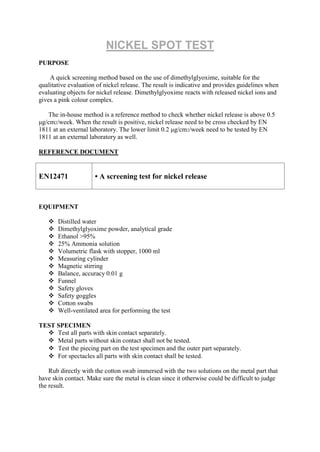
Nickel spot test
- 1. PURPOSE A quick screening method based on the use of dimethylglyoxime, suitable for the qualitative evaluation of nickel release. The result is indicative and provides guidelines when evaluating objects for nickel release. Dimethylglyoxime reacts with released nickel ions and gives a pink colour complex. The in-house method is a reference method to check whether nickel release is above 0.5 μg/cm2/week. When the result is positive, nickel release need to be cross checked by EN 1811 at an external laboratory. The lower limit 0.2 μg/cm2/week need to be tested by EN 1811 at an external laboratory as well. REFERENCE DOCUMENT EN12471 • A screening test for nickel release EQUIPMENT Distilled water Dimethylglyoxime powder, analytical grade Ethanol >95% 25% Ammonia solution Volumetric flask with stopper, 1000 ml Measuring cylinder Magnetic stirring Balance, accuracy 0.01 g Funnel Safety gloves Safety goggles Cotton swabs Well-ventilated area for performing the test TEST SPECIMEN Test all parts with skin contact separately. Metal parts without skin contact shall not be tested. Test the piecing part on the test specimen and the outer part separately. For spectacles all parts with skin contact shall be tested. Rub directly with the cotton swab immersed with the two solutions on the metal part that have skin contact. Make sure the metal is clean since it otherwise could be difficult to judge the result.
- 2. METHOD NOTE: If you purchase ready-made solutions, also make sure to apply any procedure recommended by the supplier. Preparation of solutions Dimethylglyoxime 0.8% Weigh (8.0g±0.5)g of dimethylglyoxime into a 1000 ml flask with stopper. Add ~900 ml ethanol (>95%) and place the flask on magnetic stirring until the dimethylglyoxime is solved. Add ethanol so the total volume is exactly 1000 ml. Ammonia solution, 10% (m/m) Measure 420 ml of ammonia solution (25%) and mix with 500 ml distilled water. Stir and allow cooling to room temperature (if necessary). Add distilled water so the total volume is exactly 1000 ml. The ammonia and dimethylglyoxime solutions are stable for 6 months at a temperature below 25°C. After this time there is a risk that the solutions will not work correctly. If possible it is best to keep the solutions in a refrigerator. Test method 1. Moisten a cotton swab with two drops of each solution. It is important that it is exactly two drops of each solution and not more or less. It does not matter which chemical is added first, but the two chemicals shall be mixed on the cotton swab. Rub quite hard on the area to be tested for 30 seconds, not shorter and not longer. Use a clock that shows seconds. The appearance of pink colour, from light pink to strong cerise indicates nickel release. Other colours, green, grey, brown or blue indicates other metals or dirt: in these cases the sample is OK. 1. Put two drops of each solution on a cotton swab. It does not matter which one you put on first, but the two solutions shall mix together on the swab. 2. Rub quite hard on the object for 30 seconds, not shorter or longer.
- 3. RESULTS If the cotton swab turns pink it should be reported as “+ “(= NOT OK). If the cotton swab does not turn pink it should be reported as “– “(= OK). If there are difficulties in judging the result, a sample can be sent to an external lab for nickel release test according to EN 1811. EN 1811 gives a quantitative result and takes 9-10 business days for the external lab to perform. SAFETY The chemicals used shall be handled with care! Protective eye goggles shall be used when performing the test, in order to avoid getting chemicals in the eyes. If this should happen, the eyes need to be rinsed with water for 30 minutes to avoid damages. A doctor should be consulted Prepared By: BALAJI.T.R (Lab Incharge) SNQS INTERNATIONAL. TIRUPPUR.
